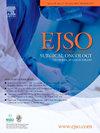高胆红素血症不会损害门静脉栓塞后诱导的肝脏肥厚——一项回顾性斯堪的纳维亚队列研究
IF 3.5
2区 医学
Q2 ONCOLOGY
引用次数: 0
摘要
背景:在肝大切除术前,门静脉栓塞(PVE)可用于诱导未来肝残体(FLR)的肥厚。高胆红素血症对PVE术后FLR肥大的影响尚存争议。本研究的目的是比较p -胆红素升高和非p -胆红素升高患者PVE后FLR肥大的情况。材料/方法这是一项斯堪的纳维亚回顾性队列研究,纳入了来自五个肝胆中心的患者。该研究包括2013年至2023年接受右侧PVE的患者。数据是从电子病历中收集的。分析FLR生长与p -胆红素正常或升高的关系。结果本研究共纳入410例患者。在整个队列中,105例患者在PVE时p -胆红素水平升高(≥26 μmol/L)。p -胆红素水平升高与PVE后FLR肥厚受损无关,由绝对生长确定(p <;0.001),相对生长(p = 0.008),肥大程度(p <;0.001)和动态增长率(p = 0.002)。多变量分析显示,PVE时p -胆红素水平升高(p = 0.002)以及使用n -氰基丙烯酸丁酯(NBCA)作为栓塞材料(p = 0.009)与FLR肥大增加相关。估测肝总容量越大,与FLR肥厚减少有关(p <;0.001)。结论在这项多中心、回顾性队列研究中,我们没有发现p -胆红素升高对PVE时FLR肥大有任何负面影响。PVE前p -胆红素水平不需要恢复正常。这项研究支持了将NBCA作为栓塞材料的持续转变。本文章由计算机程序翻译,如有差异,请以英文原文为准。
Hyperbilirubinemia does not impair induced liver hypertrophy after portal vein Embolization—a retrospective scandinavian cohort study
Background
Portal vein embolization (PVE) may be used to induce hypertrophy of the future liver remnant (FLR) before major hepatectomy. The influence of hyperbilirubinemia on FLR hypertrophy after PVE is controversial. The aim of this study was to compare FLR hypertrophy after PVE between patients with and without elevated P-bilirubin.
Materials/methods
This is a Scandinavian retrospective cohort study of patients from five hepatobiliary centres. This study included patients who underwent right-sided PVE from 2013 to 2023. Data were collected from electronic medical records. FLR growth was analysed with respect to normal or elevated P-bilirubin.
Results
In total, 410 patients were included in this study. Among the total cohort, 105 patients had elevated P-bilirubin levels (≥26 μmol/L) at the time of PVE. Elevated P-bilirubin levels were not associated with impaired FLR hypertrophy after PVE, as determined by absolute growth (p < 0.001), relative growth (p = 0.008), degree of hypertrophy (p < 0.001) and kinetic growth rate (p = 0.002). Multivariable analysis revealed that elevated P-bilirubin levels at the time of PVE (p = 0.002) together with the use of N-butyl cyanoacrylate (NBCA) as an embolizing material (p = 0.009) were associated with increased FLR hypertrophy. A larger estimated total liver volume was associated with reduced FLR hypertrophy (p < 0.001).
Conclusion
In this multicentre, retrospective cohort study, we were unable to show any negative effect of elevated P-bilirubin on FLR hypertrophy at the time of PVE. There is no need for P-bilirubin levels to normalize before PVE. This study supports the ongoing shift towards NBCA as an embolizing material.
求助全文
通过发布文献求助,成功后即可免费获取论文全文。
去求助
来源期刊

Ejso
医学-外科
CiteScore
6.40
自引率
2.60%
发文量
1148
审稿时长
41 days
期刊介绍:
JSO - European Journal of Surgical Oncology ("the Journal of Cancer Surgery") is the Official Journal of the European Society of Surgical Oncology and BASO ~ the Association for Cancer Surgery.
The EJSO aims to advance surgical oncology research and practice through the publication of original research articles, review articles, editorials, debates and correspondence.
 求助内容:
求助内容: 应助结果提醒方式:
应助结果提醒方式:


